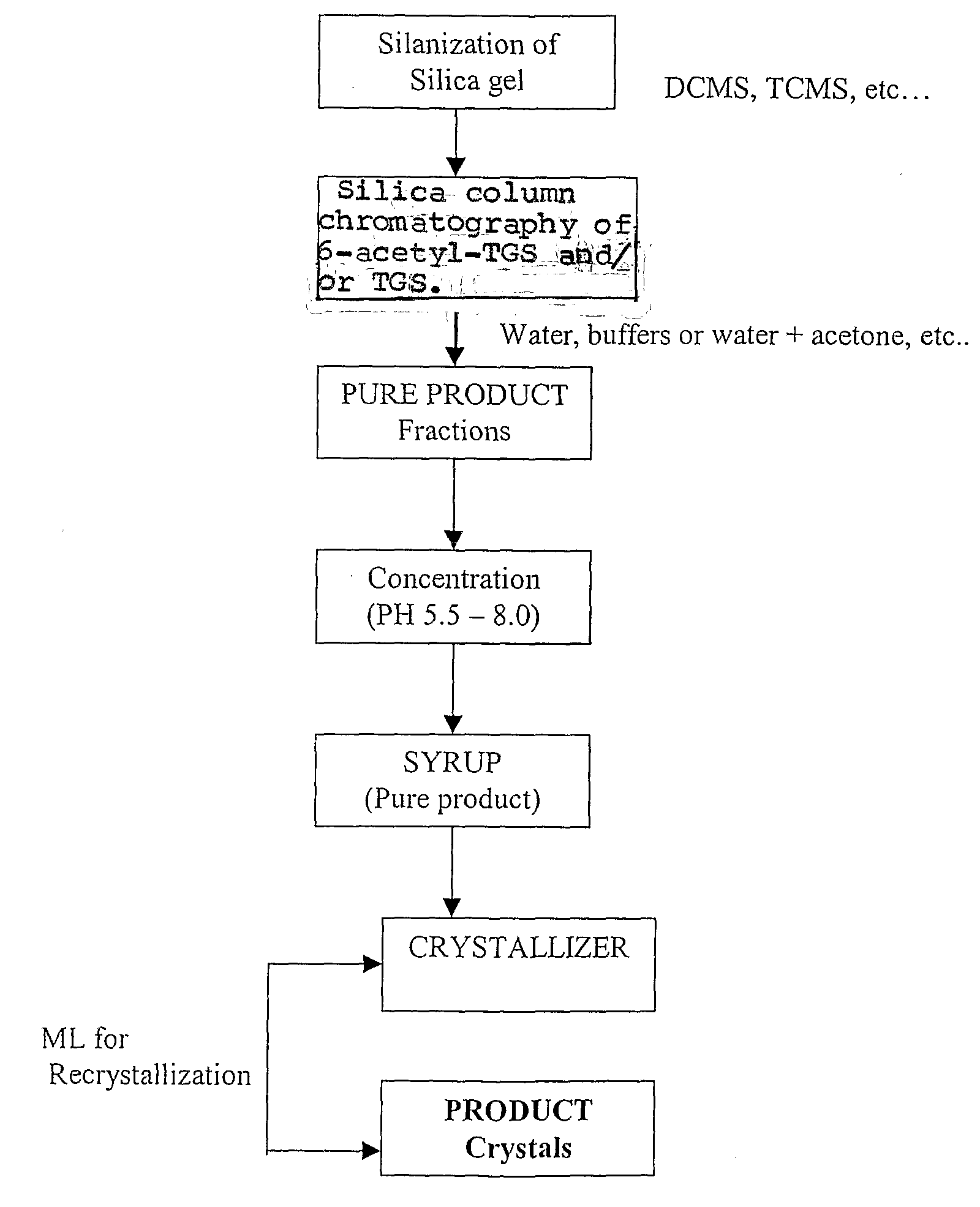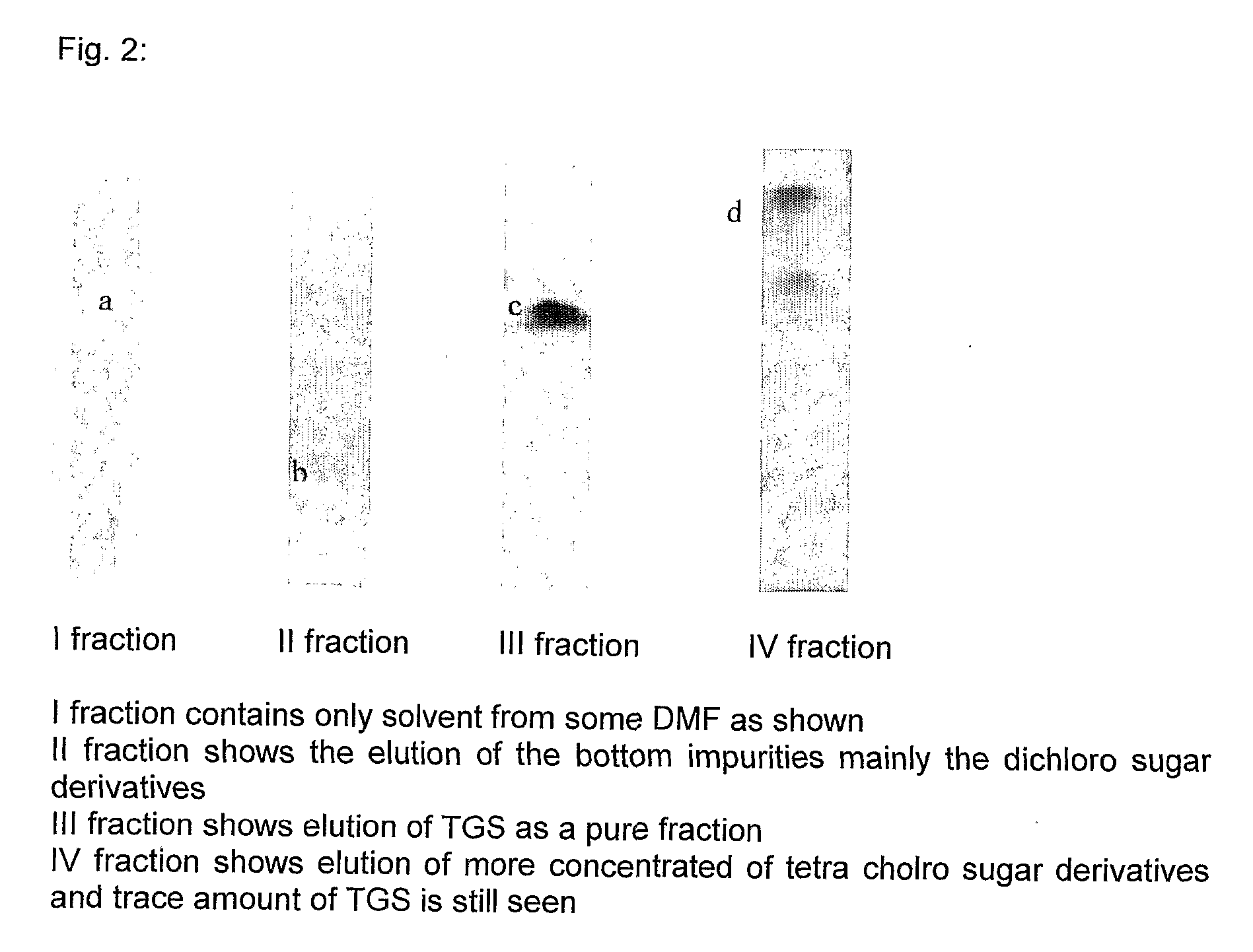Process for Purification of 6 Acetyl 4,1', 6' Trichlorogalactosucrose and 4,1', 6' Trichlorogalactosucrose by Chromatography on Silanized Silica Gel
a technology of chlorinated sucrose and acetyl trichlorogalactosucrose, which is applied in the direction of sugar derivates, separation processes, organic chemistry, etc., can solve the problems of insufficient clarity, insufficient wording, and inability to make clear
- Summary
- Abstract
- Description
- Claims
- Application Information
AI Technical Summary
Benefits of technology
Problems solved by technology
Method used
Image
Examples
example 1
[0039] Preparation of Silanized Silica Gel
[0040] 200 kg of silica gel (230 to 400 mesh size) was taken slurried in 400 L of toluene in a glass lined reactor. The uniform slurry was prepared in the reactor with constant mixing for 30 minutes, following which 100 L of trimethylchlorosilane was added. The mixture was mixed thoroughly at slightly elevated temperature of up to 45° C. After 2 hours of stirring, the silica gel was filtered through the nutsche filter and the mother liquour was collected separately. The silica gel cake obtained was washed with 200 L of methanol thoroughly to remove toluene traces and washed with water.
[0041] 15 kg of sucrose-6-acetate was taken for chlorination. The Vilsmeier-Haack reagent was prepared by taking 63 kg of PCl5 and 255 L of DMF in glass lined reactor. Then the Vilsmeier-Haack reagent formed was cooled to 0° C. and then the sucrose-6-acetate was added with continuous stirring Then the reaction mixture was allowed to come to room temperature a...
example 2
[0047] 12 kg of sucrose-6-acetate was taken for chlorination. The Vilsmeier-Haack reagent was prepared by taking 50 kg of PCl5 and 255 L of DMF in glass lined reactor. Then the Vilsmeier-Haack reagent formed was cooled to 0° C. and then the sucrose-6-acetate was added with continuous stirring. Then the reaction mixture was allowed to come to room temperature and heated to 80° C., maintained for 3 hours, further heated to 100° C. and maintained for 6 hours. Then the reaction mixture was heated up to 115° C. and maintained for 90 minutes and then neutralized with water and calcium hydroxide up to pH 7.5. The neutralized mass containing the 6-acetyl TGS was then subjected to ATFD for DMF removal.
[0048] The ATFD powder thus obtained was then dissolved in 1:3 times of water and the pH was adjusted to neutral and extracted into 1:3 times of ethyl acetate. The ethyl acetate was then distilled off under vacuum and then the syrup obtained was taken for column chromatographic purification.
[...
example 3
[0053] An experiment was conducted to compare between the use of normal silica gel and Silanized silica gel for column chromatographic purification of TGS. The crude quantity of mixture of reactants subjected for chromatography was 100 kg (15 kg of TGS). Two columns (750 mm×3150 mm) were taken for the experiment, one for loading with normal silica gel and other for leading with Silanized silica gel. Each of the column was packed with 800 kg of the respective silica gel. The normal silica was eluted with varying proportions of ethyl acetate and methylene dichloride as mobile phase and the Silanized silica was eluted with pH 9.0 sodium acetate buffer. The different fractions obtained and their profiles are shown in Table 3 below:
TABLE 3Normal silica gelTGS in eluentSilanized silica gelTGS in eluentFractions volume(kg)Fractions volume(kg) 0 L to 550 L 0 g550 L 0 g 550 to 1250 L0.23 kg550 L to 700 L0.12 kg1250 L to 1750 L0.63 kg700 L to 850 L 4.4 kg1750 L to 2250 L2.36 kg 850 L to...
PUM
| Property | Measurement | Unit |
|---|---|---|
| Fraction | aaaaa | aaaaa |
| Fraction | aaaaa | aaaaa |
| Volume | aaaaa | aaaaa |
Abstract
Description
Claims
Application Information
 Login to View More
Login to View More - R&D
- Intellectual Property
- Life Sciences
- Materials
- Tech Scout
- Unparalleled Data Quality
- Higher Quality Content
- 60% Fewer Hallucinations
Browse by: Latest US Patents, China's latest patents, Technical Efficacy Thesaurus, Application Domain, Technology Topic, Popular Technical Reports.
© 2025 PatSnap. All rights reserved.Legal|Privacy policy|Modern Slavery Act Transparency Statement|Sitemap|About US| Contact US: help@patsnap.com



